Wood deck railings serve as both essential safety features and defining design elements that can dramatically transform your outdoor living space. From classic traditional styles to contemporary innovations, these versatile structures offer endless possibilities for personal expression while meeting building code requirements. Whether you prefer the timeless appeal of vertical balusters, the modern sophistication of horizontal slats, or the rustic charm of natural logs, the right railing design can enhance your deck's aesthetic and complement your home's architecture. Today's homeowners have access to numerous creative approaches that combine functionality with striking visual impact, making it easier than ever to create an outdoor sanctuary that reflects individual style preferences.

1. Traditional Wood Deck Railing with Vertical Balusters

Classic wooden railings featuring evenly spaced vertical balusters remain one of the most popular and timeless designs for outdoor spaces. This traditional approach typically uses pressure-treated lumber or cedar for both posts and spindles, creating a cohesive look that complements virtually any home style. The vertical elements, usually 2x2 balusters, are positioned between top and bottom rails with precise spacing to meet safety codes while maintaining an open feel. A substantial cap rail crowns the design, providing a comfortable resting surface and visual weight. This style works exceptionally well with colonial, craftsman, and farmhouse architecture, offering reliable durability and straightforward maintenance requirements.
2. Horizontal Wood Deck Railing with Slat Design
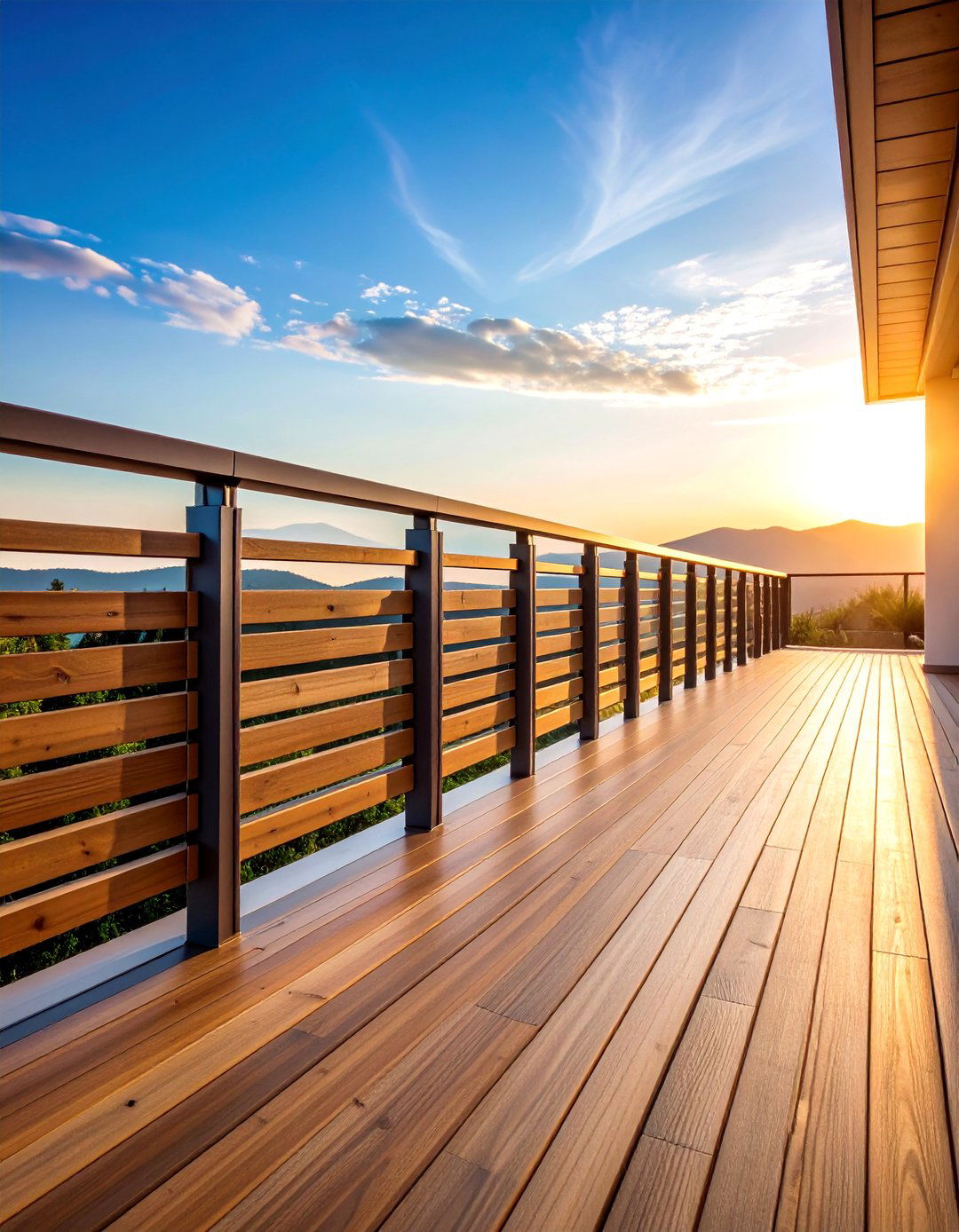
Modern horizontal slat railings create clean, contemporary lines that make outdoor spaces appear larger and more expansive. This design features thin wooden boards, typically 1x4 or 2x4 lumber, mounted horizontally between sturdy posts with strategic spacing for both safety and visual appeal. The horizontal orientation draws the eye across the deck rather than upward, creating an illusion of greater width. Cedar and pressure-treated pine are popular material choices for their weather resistance and natural beauty. This style pairs perfectly with modern and mid-century home designs, offering excellent airflow while maintaining privacy levels that can be adjusted through board spacing variations.
3. Wood Deck Railing with Lattice Panel Inserts

Decorative lattice panels transform standard deck railings into charming architectural features that combine privacy with visual interest. Traditional diamond or square lattice patterns, constructed from thin wooden strips, create sophisticated geometric designs while allowing light and air to filter through. These panels are typically framed within sturdy wooden borders and secured between posts, offering excellent support for climbing plants and vines. The lattice work adds texture and depth to the railing system while maintaining structural integrity. This design approach works beautifully with cottage, Victorian, and traditional home styles, providing opportunities for seasonal decoration and garden integration that enhances the overall outdoor living experience.
4. Rustic Wood Deck Railing with Natural Log Construction
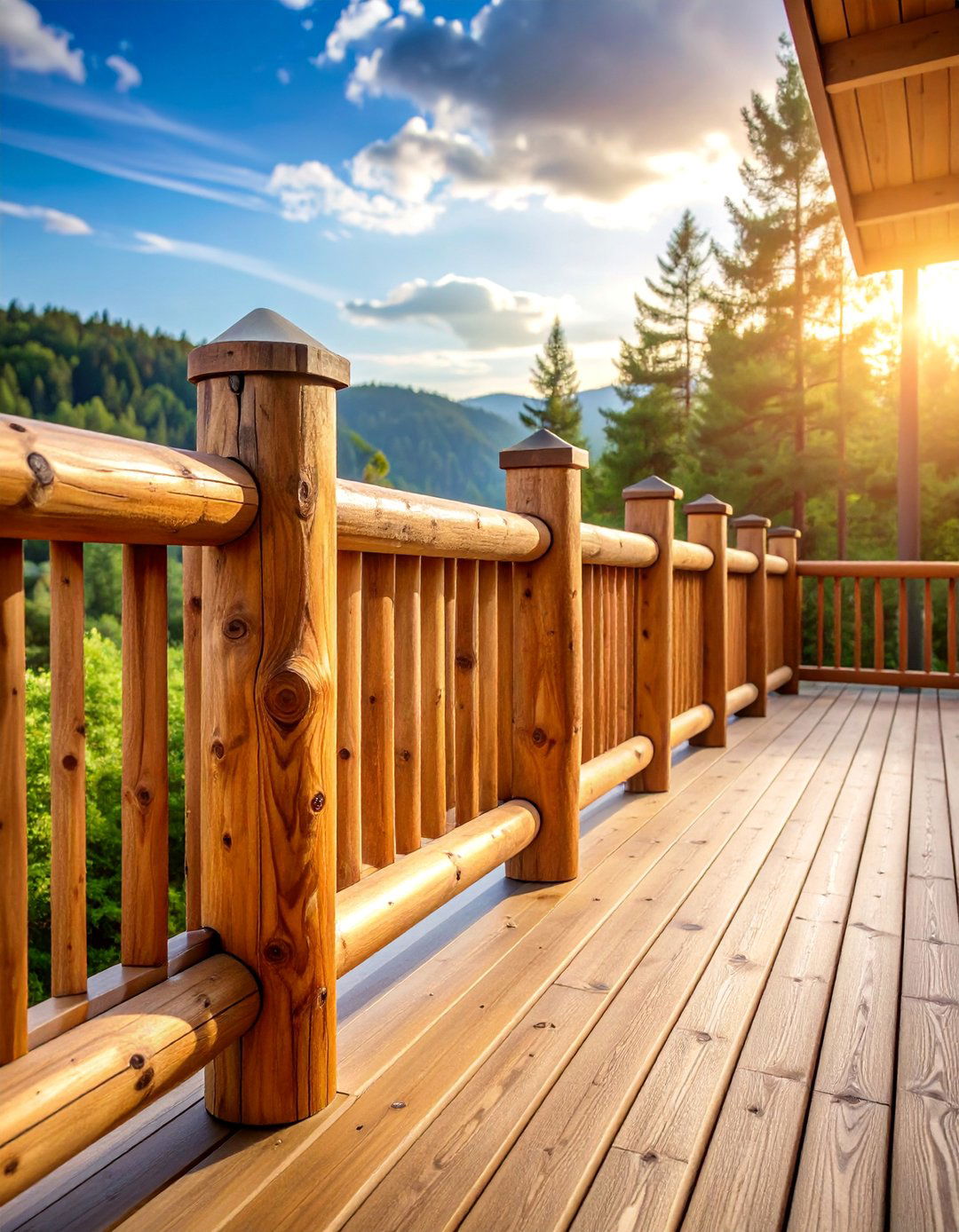
Natural log railings bring authentic cabin charm and organic appeal to outdoor decks, creating seamless connections with wooded environments. This rustic design typically features peeled or rough-hewn logs as both posts and rails, showcasing the natural grain patterns and textures of cedar, pine, or hickory. The logs are carefully selected for straightness and durability, then secured with traditional joinery techniques or modern hardware that remains hidden from view. Balusters may be smaller logs or branches, maintaining the natural theme throughout. This style perfectly complements log homes, mountain retreats, and rustic cabins, offering exceptional longevity when properly treated and maintained for weather resistance.
5. Wood Deck Railing with X-Pattern Chippendale Design

Chippendale-style railings featuring distinctive X-patterns add classical elegance and architectural sophistication to deck spaces. This decorative approach combines intersecting diagonal boards that form eye-catching geometric patterns between posts, often enhanced with additional lattice or spindle work. The traditional design originated from 18th-century furniture styling and translates beautifully to outdoor applications. Quality construction typically uses cedar or mahogany for optimal weather resistance and visual appeal. Each panel requires precise measurement and cutting to ensure pattern alignment and structural integrity. This ornate style works exceptionally well with colonial, Georgian, and traditional home designs, creating focal points that demonstrate craftsmanship while providing necessary safety barriers for elevated decks.
6. Wood Deck Railing with Mixed Material Integration

Contemporary mixed-material railings combine natural wood elements with metal components for striking visual contrast and enhanced durability. This innovative approach typically features wooden posts and cap rails paired with aluminum or steel balusters, cable inserts, or decorative metal panels. The combination allows homeowners to enjoy wood's warmth while benefiting from metal's low maintenance requirements and structural strength. Popular configurations include cedar frames with black powder-coated metal infill, creating bold statements that complement both traditional and modern architecture. This design flexibility enables customization to match specific home styles while reducing long-term maintenance needs compared to all-wood systems, making it increasingly popular among contemporary homeowners.
7. Wood Deck Railing with Built-in Bench Seating
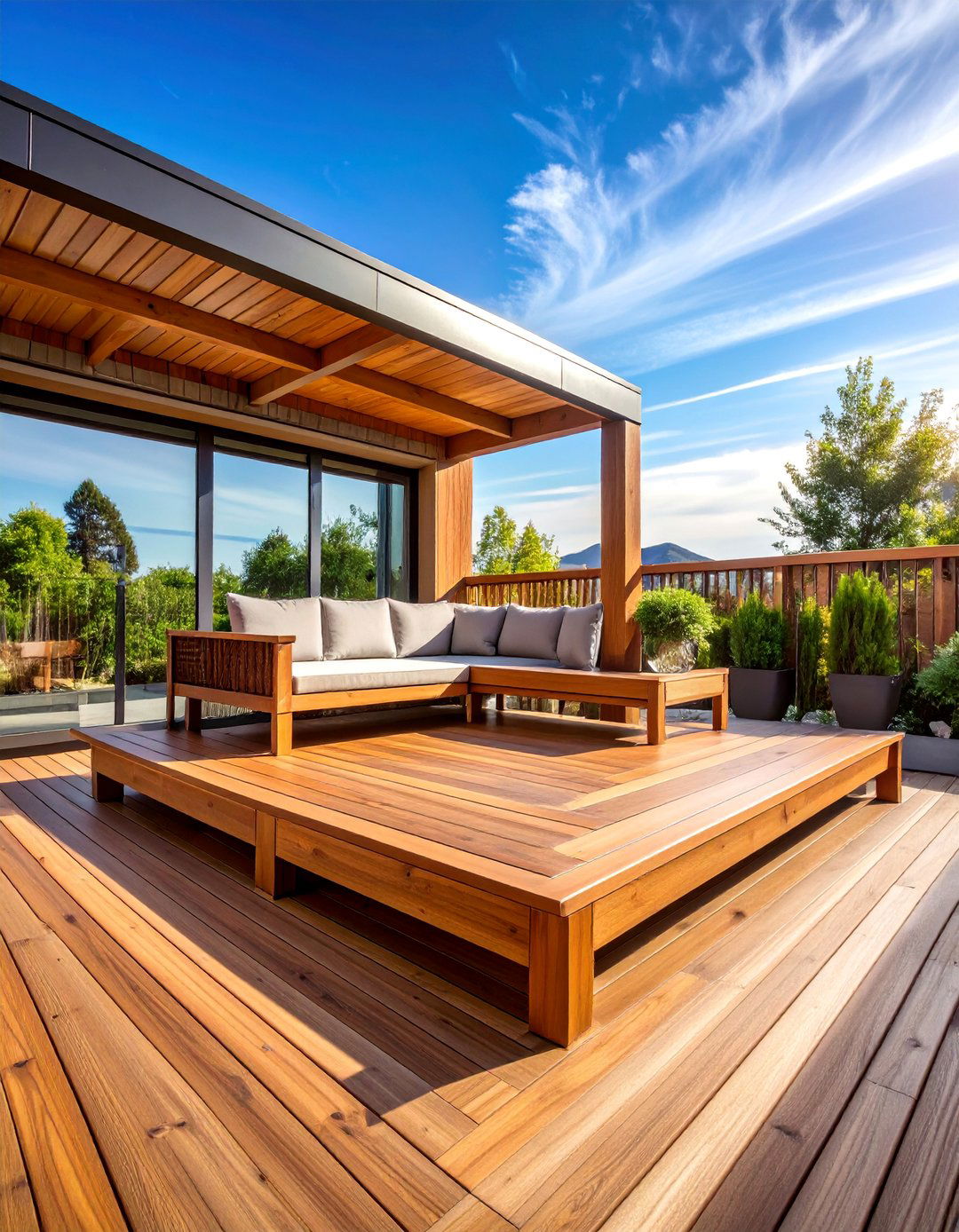
Integrated bench seating transforms deck railings into multifunctional elements that maximize space efficiency while providing comfortable outdoor furniture. This clever design incorporates wide horizontal boards or built-up platforms at standard seating height, typically 16-18 inches, supported by the railing's structural framework. The bench backs can feature traditional balusters, solid boards, or decorative patterns while maintaining code-compliant heights above. Storage compartments underneath the seating areas add practical functionality for cushions, garden tools, or outdoor accessories. Cedar and pressure-treated lumber offer excellent weather resistance for these high-use applications. This space-saving solution works particularly well on smaller decks where separate furniture might feel cramped or overwhelming.
8. Wood Deck Railing with Decorative Turned Balusters
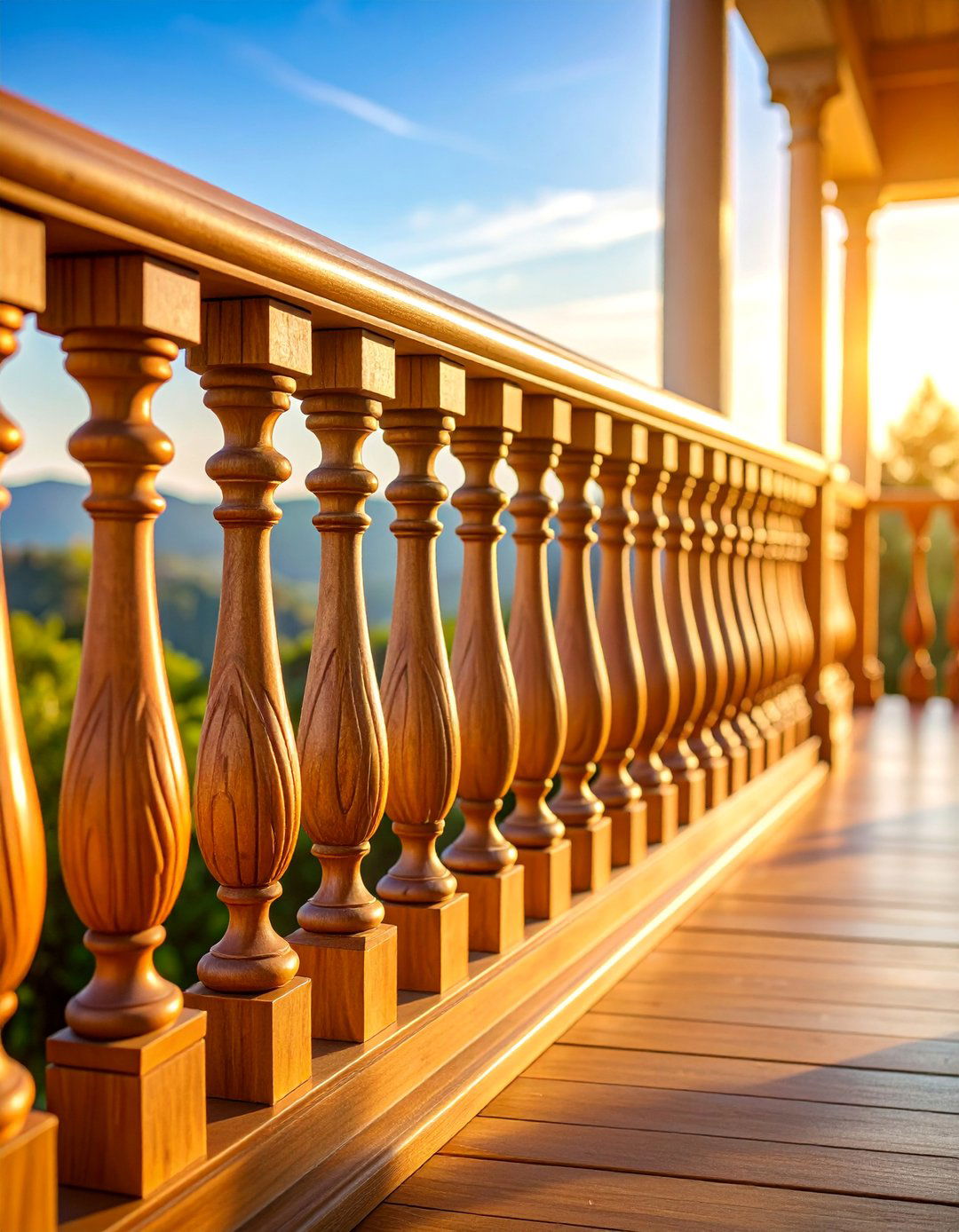
Ornate turned balusters elevate simple deck railings into sophisticated architectural statements through intricate craftsmanship and classical design elements. These decorative spindles feature carved details such as flutes, bulbous sections, and tapered profiles that catch light and create visual interest throughout the day. Traditional turning techniques create symmetrical patterns that reference historical design periods while providing modern functionality. Quality hardwoods like oak, mahogany, or cedar ensure longevity and weather resistance when properly finished. Each baluster is individually crafted and precisely positioned to maintain consistent spacing and alignment. This elegant approach suits Victorian, colonial, and craftsman home styles, adding sophisticated charm that distinguishes premium deck installations from standard constructions.
9. Wood Deck Railing with Privacy Screen Panels

Solid wood privacy panels create intimate outdoor retreats while maintaining attractive design aesthetics and structural integrity. These full-height screens typically use horizontal or vertical boards with minimal gaps, providing excellent privacy from neighboring properties while allowing air circulation. Strategic board spacing can be adjusted to balance privacy needs with ventilation requirements. Cedar naturally resists insects and weather, making it ideal for privacy applications. The panels can incorporate decorative elements like routered edges, varied board widths, or geometric cutouts that add visual interest without compromising privacy. This design works exceptionally well for urban decks, pool areas, or anywhere peaceful seclusion enhances outdoor living experiences.
10. Wood Deck Railing with Sunburst Pattern Design
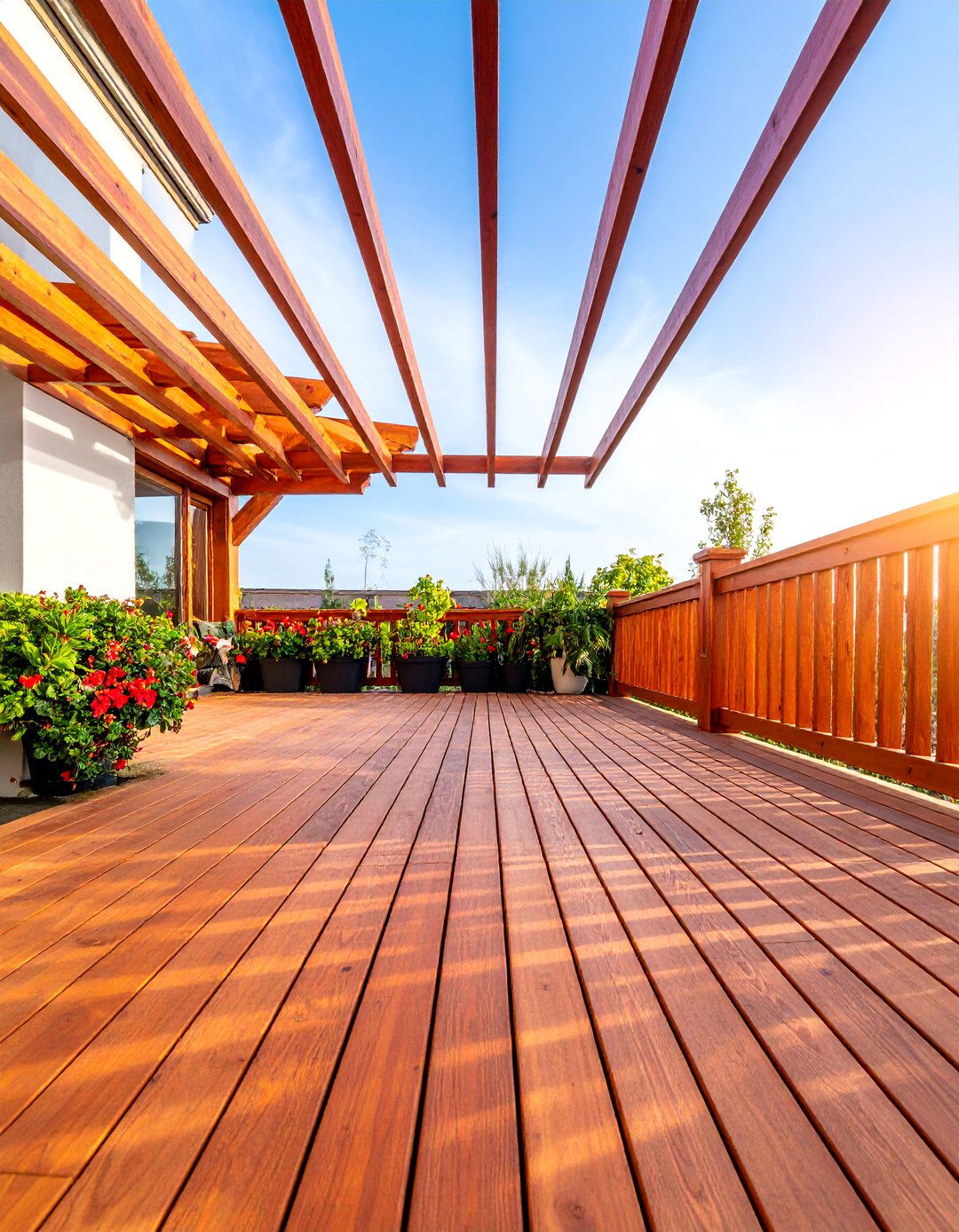
Sunburst railings create striking focal points through radiating patterns that draw attention and add architectural drama to outdoor spaces. This distinctive design features wooden boards arranged in fan-like configurations, typically emanating from central points to create dynamic visual movement. The pattern requires precise angle cutting and careful assembly to achieve proper alignment and structural integrity. Multiple sunburst sections between posts create rhythmic repetition that enhances the overall design impact. Cedar and redwood provide excellent workability for these complex cuts while offering natural weather resistance. This artistic approach suits craftsman, prairie, and arts-and-crafts home styles, creating custom appearances that showcase skilled woodworking while providing necessary safety barriers for elevated deck areas.
11. Wood Deck Railing with Diagonal Cross-Bracing
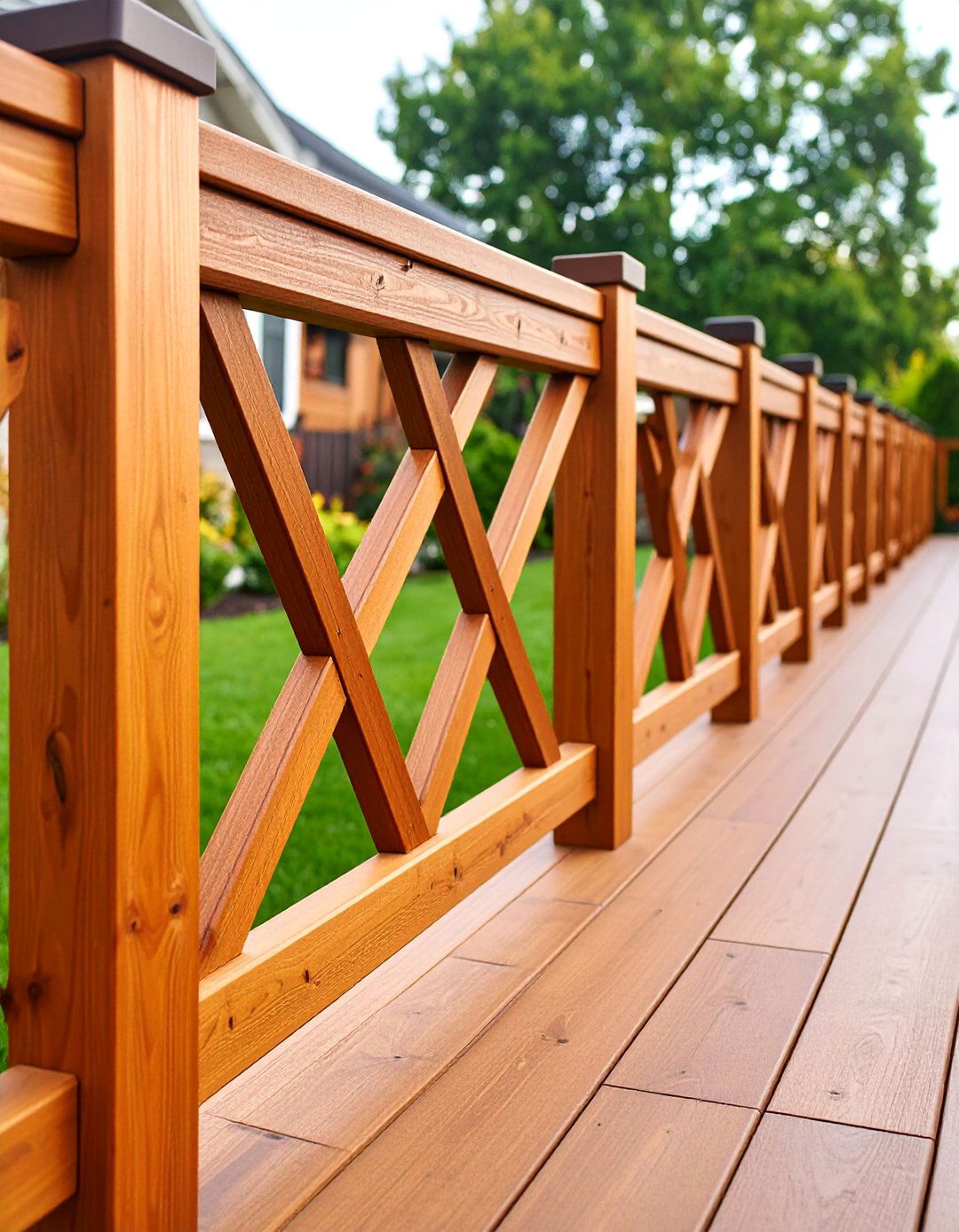
Diagonal cross-bracing patterns add structural strength and visual dynamism to deck railings through intersecting angled elements. This engineering-inspired design typically features wooden boards arranged in X-patterns or diagonal configurations that create geometric interest while providing excellent lateral stability. The angled elements can vary in width and spacing to achieve different aesthetic effects, from subtle texture to bold statements. Proper construction requires precise cutting and fitting to ensure tight joints and professional appearance. This approach works particularly well with contemporary and industrial-inspired home designs, offering both functional benefits and striking visual appeal. Cedar and pressure-treated materials provide necessary weather resistance for these complex assemblies.
12. Wood Deck Railing with Curved Spindle Elements

Gracefully curved wooden spindles introduce flowing lines and organic appeal to traditional railing designs through artfully shaped vertical elements. These custom-crafted balusters feature gentle curves, S-shapes, or wave patterns that soften the geometric rigidity of standard rectangular designs. Quality hardwoods like oak or mahogany accept detailed shaping while maintaining structural integrity and weather resistance. Each curved element requires individual crafting through steam-bending, lamination, or carving techniques that showcase traditional woodworking skills. The resulting installations create sophisticated appearances that complement Mediterranean, tropical, and contemporary home styles. This artistic approach transforms functional safety barriers into decorative architectural features that enhance outdoor living spaces with unique character and craftsmanship.
13. Wood Deck Railing with Integrated Planter Boxes

Built-in planter boxes transform deck railings into living gardens that combine safety features with horticultural opportunities. These integrated systems typically incorporate weather-resistant cedar or redwood construction with proper drainage and root barriers to protect the deck structure. The planters can be positioned at various heights within the railing framework, from ground-level herb gardens to elevated flower displays. Strategic placement allows for cascading plants that create natural privacy screens while adding color and fragrance to outdoor spaces. This design requires careful waterproofing and drainage planning to prevent moisture damage. The living elements change seasonally, providing dynamic visual interest that complements both traditional and contemporary architecture while supporting sustainable gardening practices.
14. Wood Deck Railing with Gothic Arch Details

Gothic-inspired arch elements add romantic, old-world charm to deck railings through graceful curved openings and classical proportions. These decorative features typically incorporate pointed or rounded arches cut into solid panels or created through curved top rails between posts. The arch shapes can be repeated in series to create rhythmic patterns or used sparingly as accent features. Quality construction requires precise template work and skilled cutting to achieve smooth curves and consistent proportions. Cedar and redwood accept detailed shaping while providing necessary weather resistance. This sophisticated design approach complements Tudor, Mediterranean, and traditional home styles, creating outdoor spaces that feel connected to historical architectural traditions while meeting modern safety requirements.
15. Wood Deck Railing with Horizontal Groove Patterns
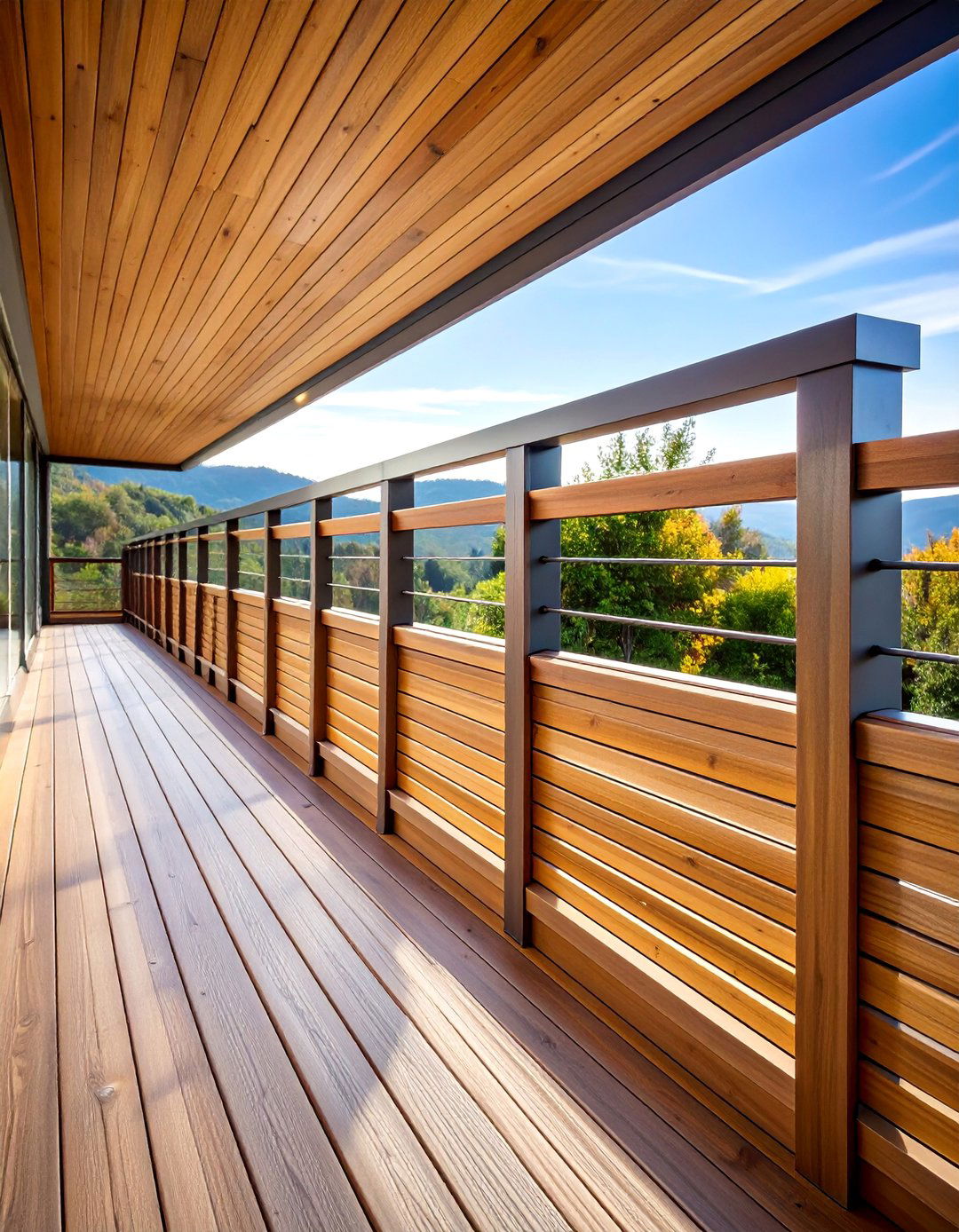
Contemporary groove patterns cut into horizontal railing boards create subtle texture and visual interest through skillful millwork and precise installation. These linear details can vary from simple routed channels to complex stepped profiles that play with light and shadow throughout the day. The grooves serve both aesthetic and practical purposes, helping boards shed water while adding sophisticated design elements. Modern CNC technology enables consistent pattern repetition across long railing runs. Cedar and redwood accept detailed milling while maintaining structural integrity and weather resistance. This refined approach suits contemporary and minimalist home designs, offering understated elegance that enhances outdoor spaces without overwhelming architectural features or natural surroundings through subtle craftsmanship details.
16. Wood Deck Railing with Trellis-Style Framework
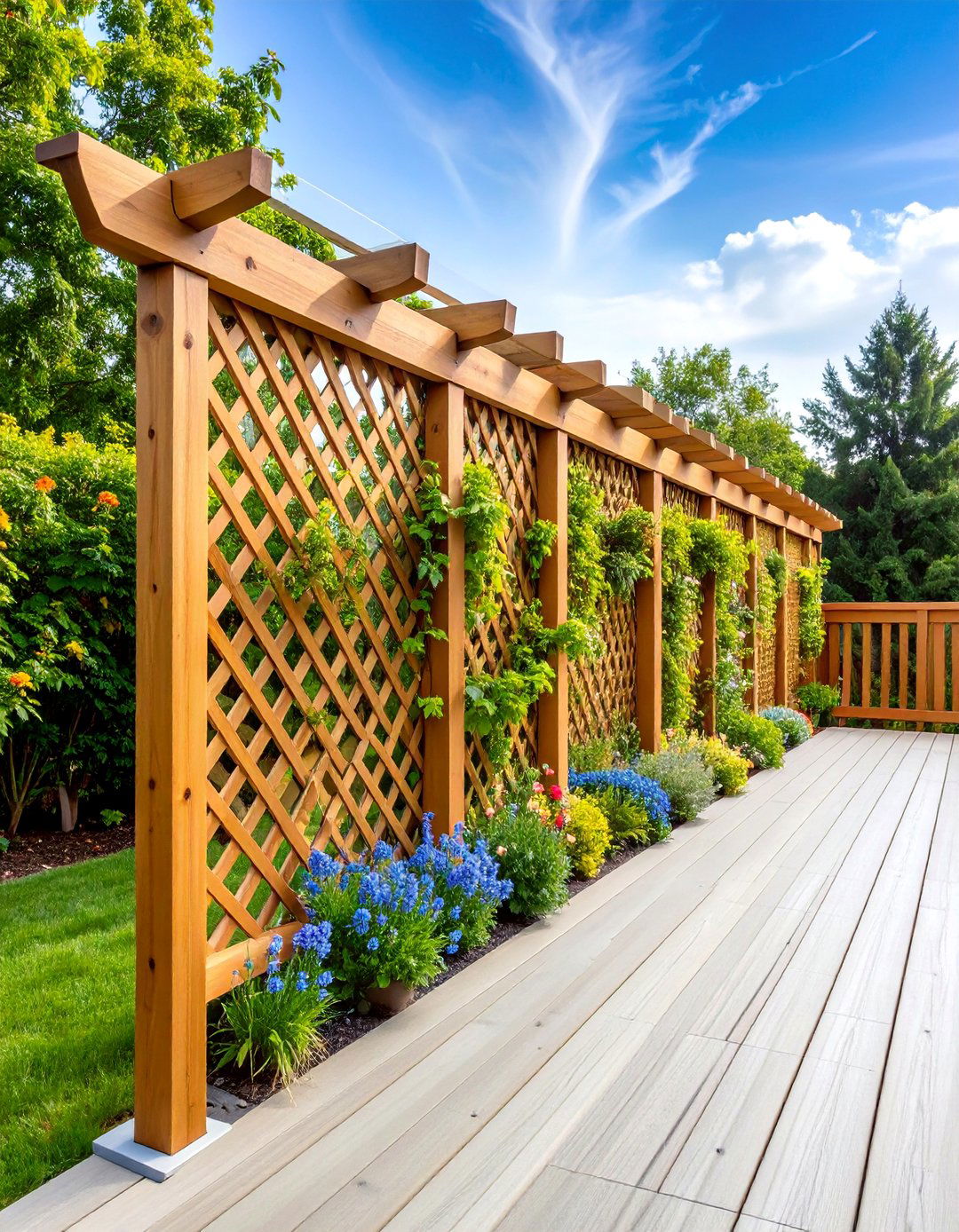
Trellis-inspired railings provide excellent support for climbing plants while creating attractive geometric frameworks that enhance garden integration. These designs typically feature grid-like patterns with larger openings than traditional lattice, optimized for plant growth and maintenance access. The framework can incorporate varying grid sizes and orientations to create visual interest while supporting different vine types. Cedar construction offers natural insect resistance and weather durability essential for garden applications. Proper spacing allows adequate air circulation while providing structural support for mature plant growth. This garden-friendly approach works beautifully with cottage, English, and naturalistic landscape designs, creating outdoor spaces that blur boundaries between built environments and natural gardens through thoughtful integration.
17. Wood Deck Railing with Multi-Level Step Design
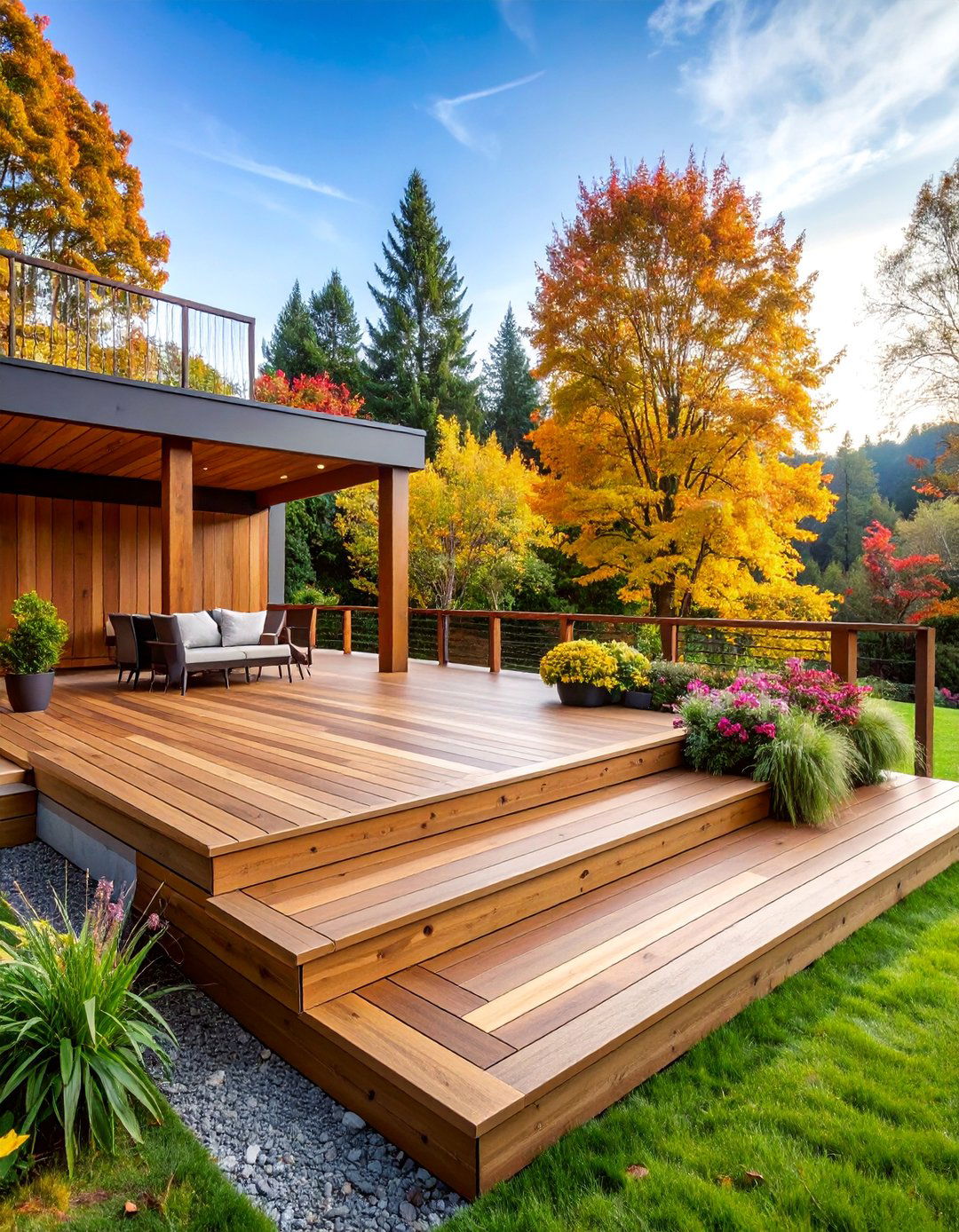
Stepped railing designs create dynamic visual profiles through varying heights and geometric arrangements that add architectural interest to outdoor spaces. These multi-dimensional installations typically feature alternating panel heights, stepped cap rails, or cascading elements that follow natural contours or design preferences. The varying levels can accommodate different functional needs, from low wind barriers to full privacy screens within the same railing system. Careful planning ensures structural integrity while achieving desired aesthetic effects. Cedar and pressure-treated materials provide necessary strength for these complex assemblies. This innovative approach suits contemporary and modern home designs, creating outdoor spaces that demonstrate architectural sophistication while providing flexible solutions for varying privacy and safety requirements.
18. Wood Deck Railing with Herringbone Pattern Infill
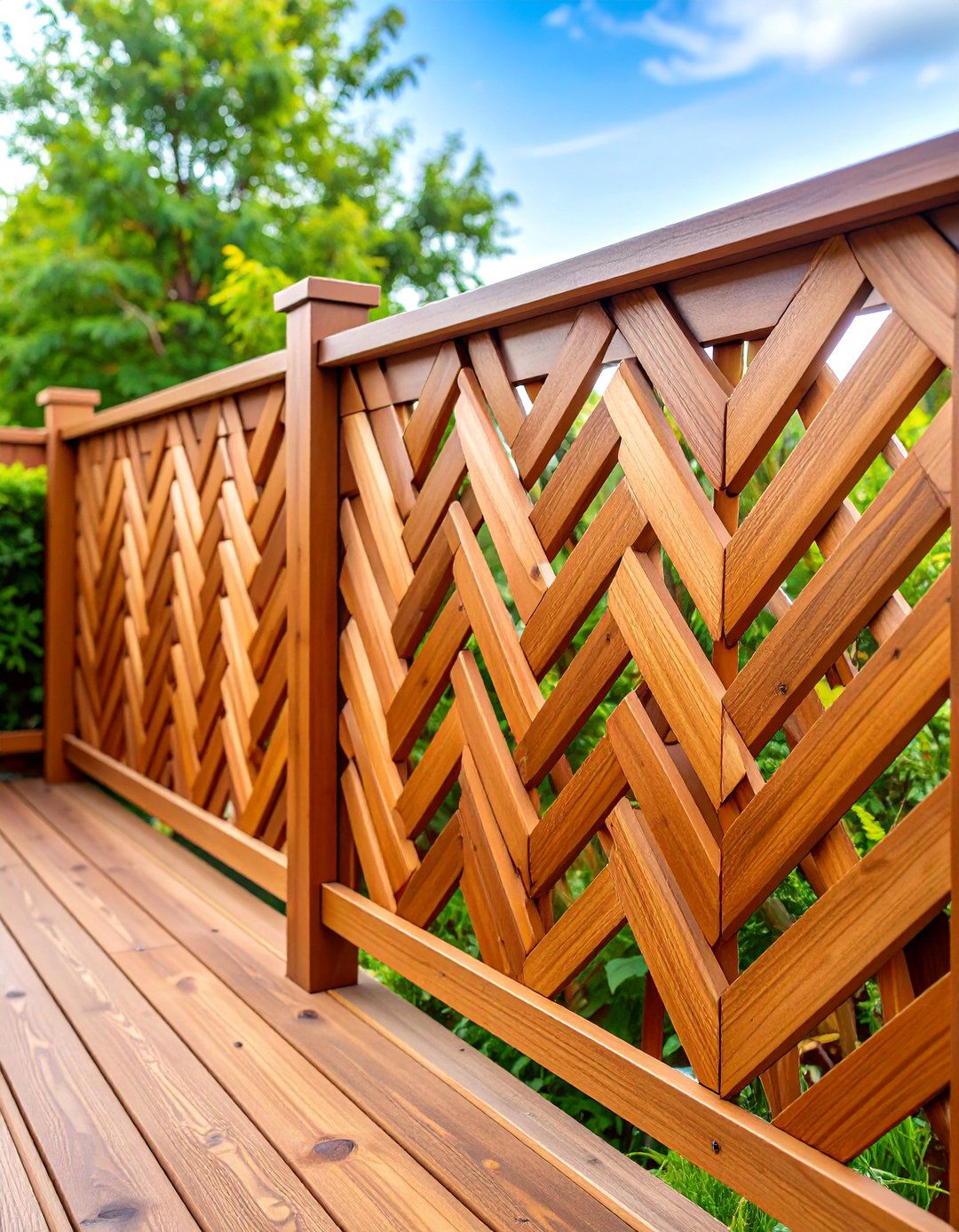
Herringbone patterns create sophisticated texture through angled board arrangements that showcase traditional woodworking techniques in contemporary applications. This classic pattern typically features wooden slats arranged in alternating V-shaped configurations that create rich visual depth and movement. The angled elements require precise cutting and fitting to achieve tight joints and professional appearance. Quality cedar or redwood construction ensures weather resistance while accepting detailed millwork. The pattern can be scaled from fine textures to bold statements depending on board dimensions and spacing. This elegant approach complements both traditional and contemporary home styles, adding sophisticated character that distinguishes premium installations while providing necessary safety barriers for elevated outdoor living spaces.
19. Wood Deck Railing with Natural Branch Elements

Incorporating natural branch elements creates unique railings that celebrate organic forms while providing rustic charm and environmental connection. These designs typically feature carefully selected and prepared branches as balusters, accent pieces, or decorative infill within traditional frameworks. The branches can be left natural or minimally processed to maintain bark texture and character. Proper selection ensures structural adequacy while treatment provides necessary longevity for outdoor exposure. This approach requires artistic sensibility to achieve balanced compositions that appear natural yet intentional. The resulting installations complement log homes, cabins, and naturalistic landscapes while creating conversation pieces that reflect individual creativity and connection to natural environments through thoughtful material selection and arrangement.
20. Wood Deck Railing with Victorian Scroll Details
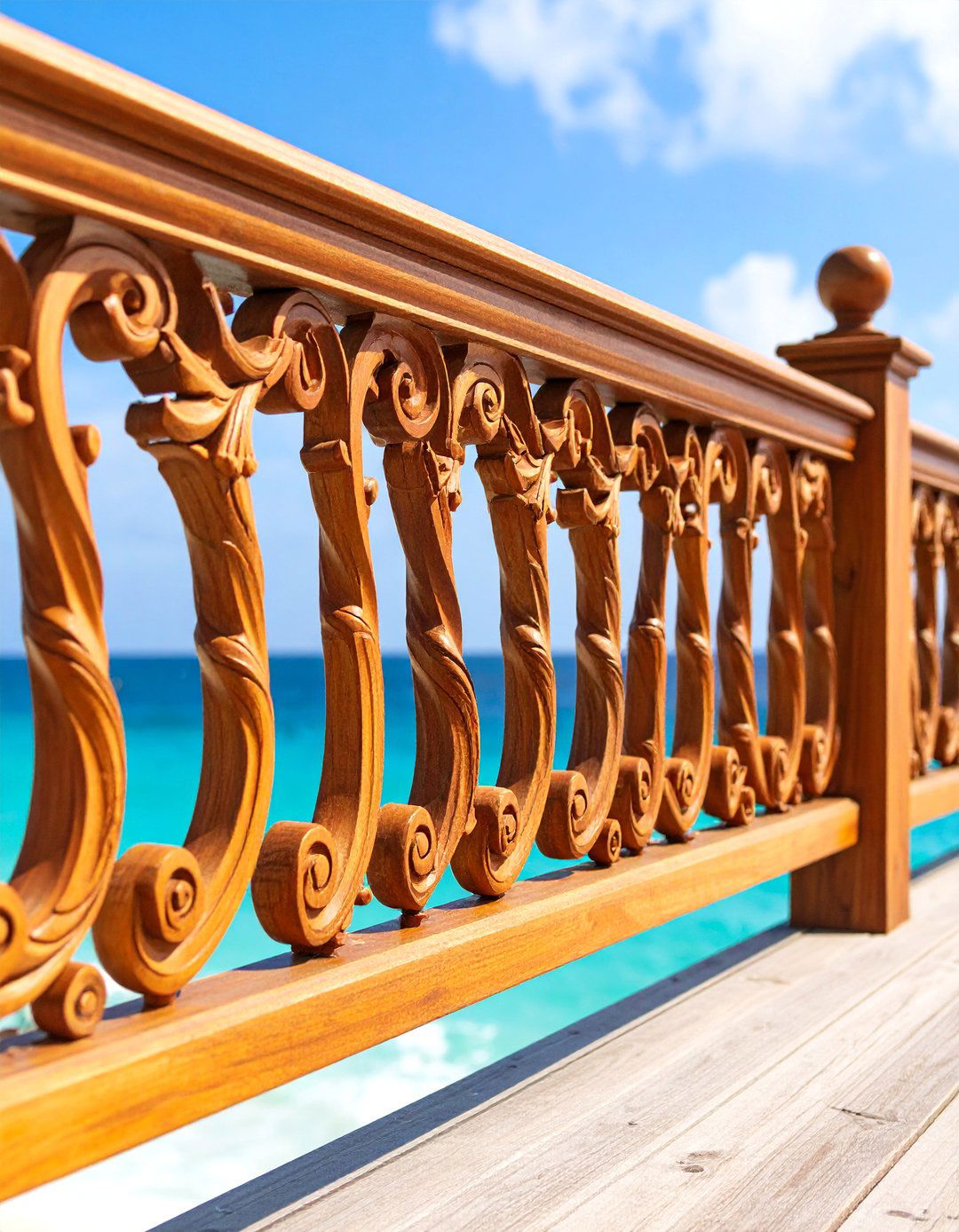
Elaborate Victorian scroll work transforms simple deck railings into ornate architectural showcases through intricate curved elements and classical proportions. These decorative features typically incorporate flowing S-curves, spirals, and organic forms that create sophisticated silhouettes against outdoor backgrounds. Quality hardwood construction ensures durability while accepting detailed shaping through traditional woodworking techniques. Each scroll element requires individual crafting and precise positioning to achieve harmonious overall compositions. The ornate details can be applied selectively as accents or extensively throughout entire installations. This elaborate approach suits Victorian, Queen Anne, and ornate traditional home styles, creating outdoor spaces that demonstrate exceptional craftsmanship while providing necessary safety features enhanced by historical design references and artistic woodworking traditions.
21. Wood Deck Railing with Coastal Weathered Finish
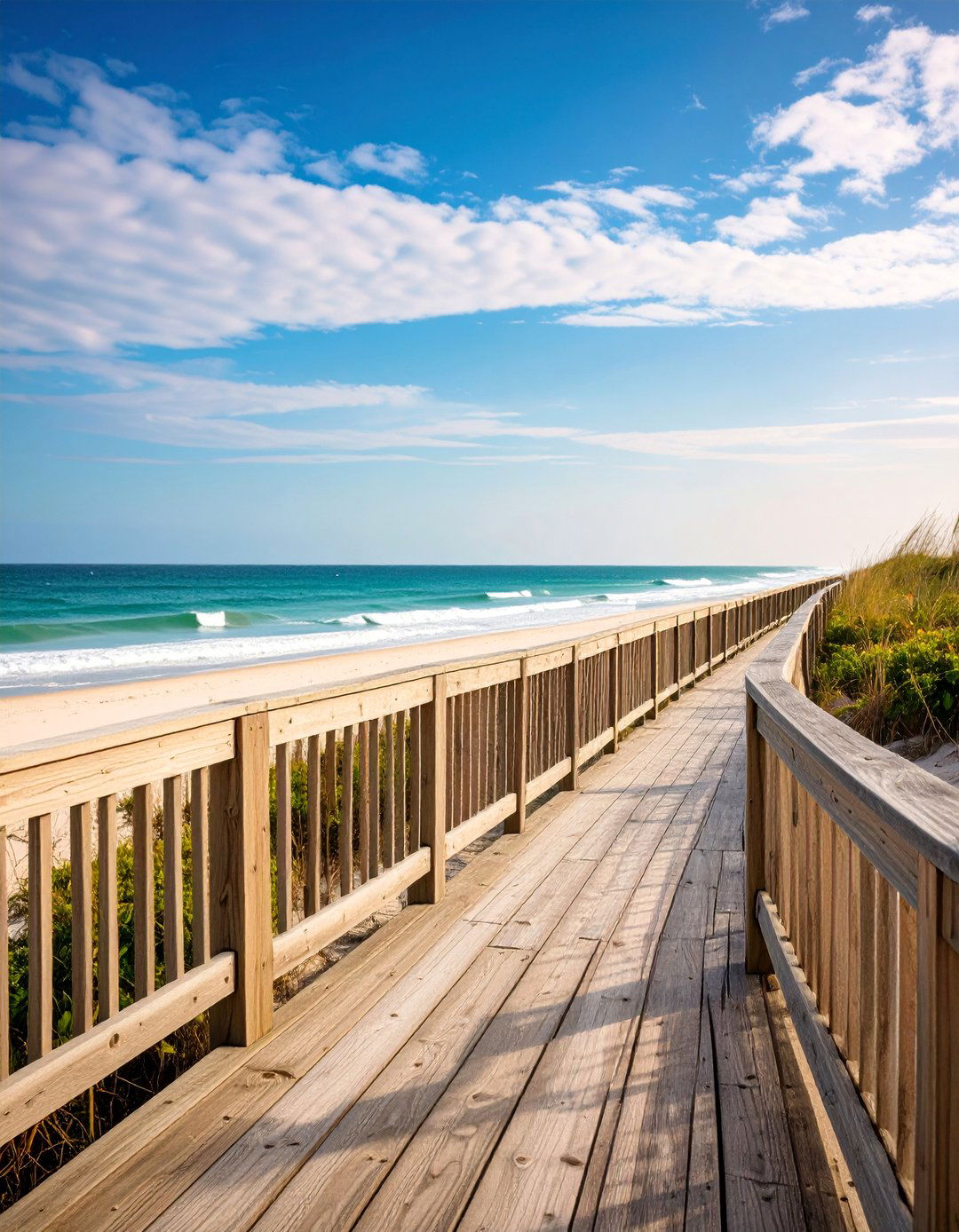
Weathered finish treatments create casual, beachside appeal through specialized techniques that replicate natural aging processes while maintaining structural integrity. These finishes typically use gray stains, bleaching compounds, or distressing methods to achieve driftwood-like appearances that complement coastal environments. The treatments can be applied to various wood species, though cedar and redwood respond particularly well to aging techniques. Multiple coat applications and careful color blending achieve authentic weathered looks without compromising wood protection. This relaxed approach suits beach houses, coastal cottages, and casual outdoor living spaces where formal appearances might feel inappropriate. The resulting installations appear naturally aged while providing modern safety features that blend seamlessly with seaside architectural traditions.
22. Wood Deck Railing with Geometric Cutout Panels

Custom geometric cutouts transform solid railing panels into artistic features that filter light while maintaining privacy and structural integrity. These decorative openings can include circles, squares, diamonds, or complex patterns that create interesting shadow play throughout the day. Modern cutting techniques enable precise, clean edges while traditional methods offer handcrafted character. The cutouts can be arranged in regular patterns or organic compositions depending on design preferences. Quality cedar construction provides excellent workability while ensuring weather resistance for these detailed applications. This creative approach suits contemporary, modern, and artistic home designs, creating outdoor spaces that function as architectural sculpture while meeting practical safety requirements through innovative design solutions that balance form and function effectively.
23. Wood Deck Railing with Craftsman-Style Details
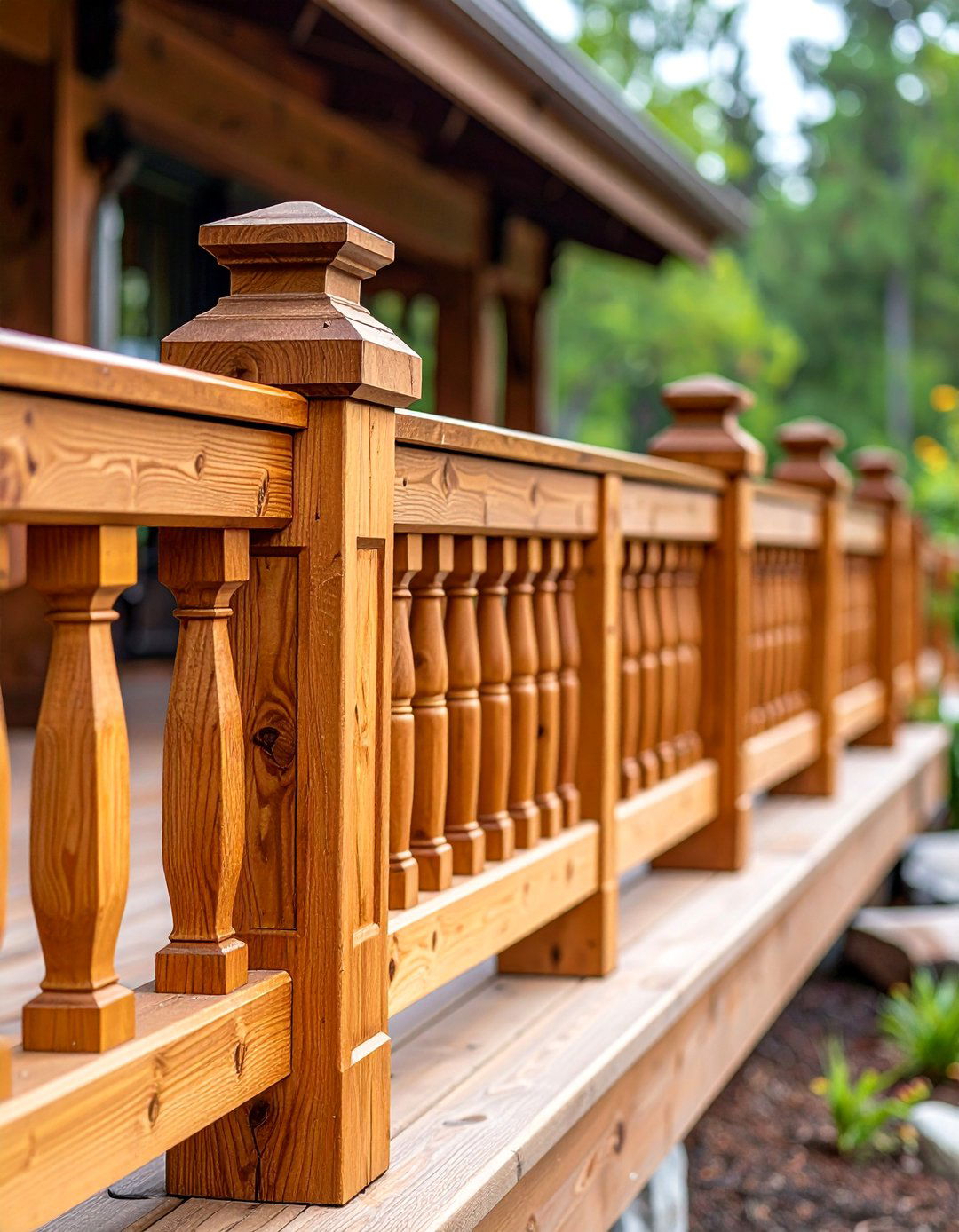
Craftsman-inspired railings emphasize honest construction and proportional relationships through substantial posts, tapered elements, and geometric simplicity. These designs typically feature thick, square posts with decorative caps, horizontal rails with subtle profiles, and carefully proportioned balusters that reflect arts-and-crafts principles. The construction showcases joinery techniques and wood grain patterns rather than applied ornamentation. Quality materials like cedar, redwood, or fir provide appropriate character while ensuring longevity. Stain finishes enhance natural wood beauty while providing weather protection. This authentic approach complements bungalow, prairie, and craftsman home styles, creating outdoor spaces that demonstrate traditional American woodworking values while providing modern safety features through time-tested construction methods and proportional relationships.
24. Wood Deck Railing with Industrial Pipe Accents
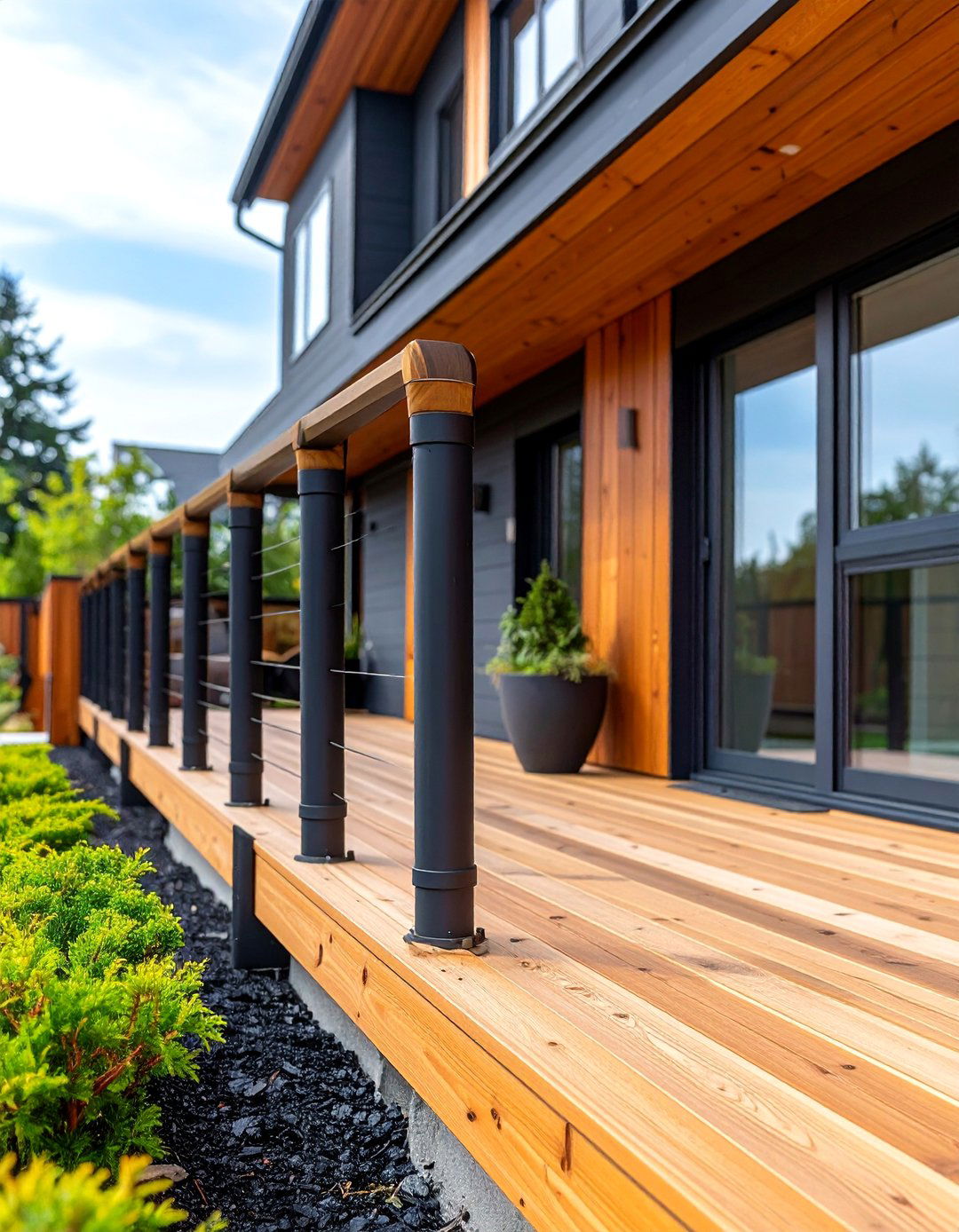
Industrial-inspired designs combine wooden frameworks with metal pipe elements for striking contemporary appearances that blend natural and manufactured materials. These hybrid systems typically feature cedar or redwood posts and rails enhanced with black iron or galvanized steel pipes as horizontal elements or decorative accents. The metal components provide structural strength while creating visual contrast against natural wood textures. Proper connection hardware ensures secure assembly while maintaining aesthetic appeal. This urban-influenced approach suits loft-style homes, contemporary designs, and converted industrial buildings where traditional railing styles might appear inappropriate. The combination offers both durability and distinctive character that reflects modern design sensibilities while providing necessary safety features for outdoor living spaces.
25. Wood Deck Railing with Sustainable Reclaimed Materials
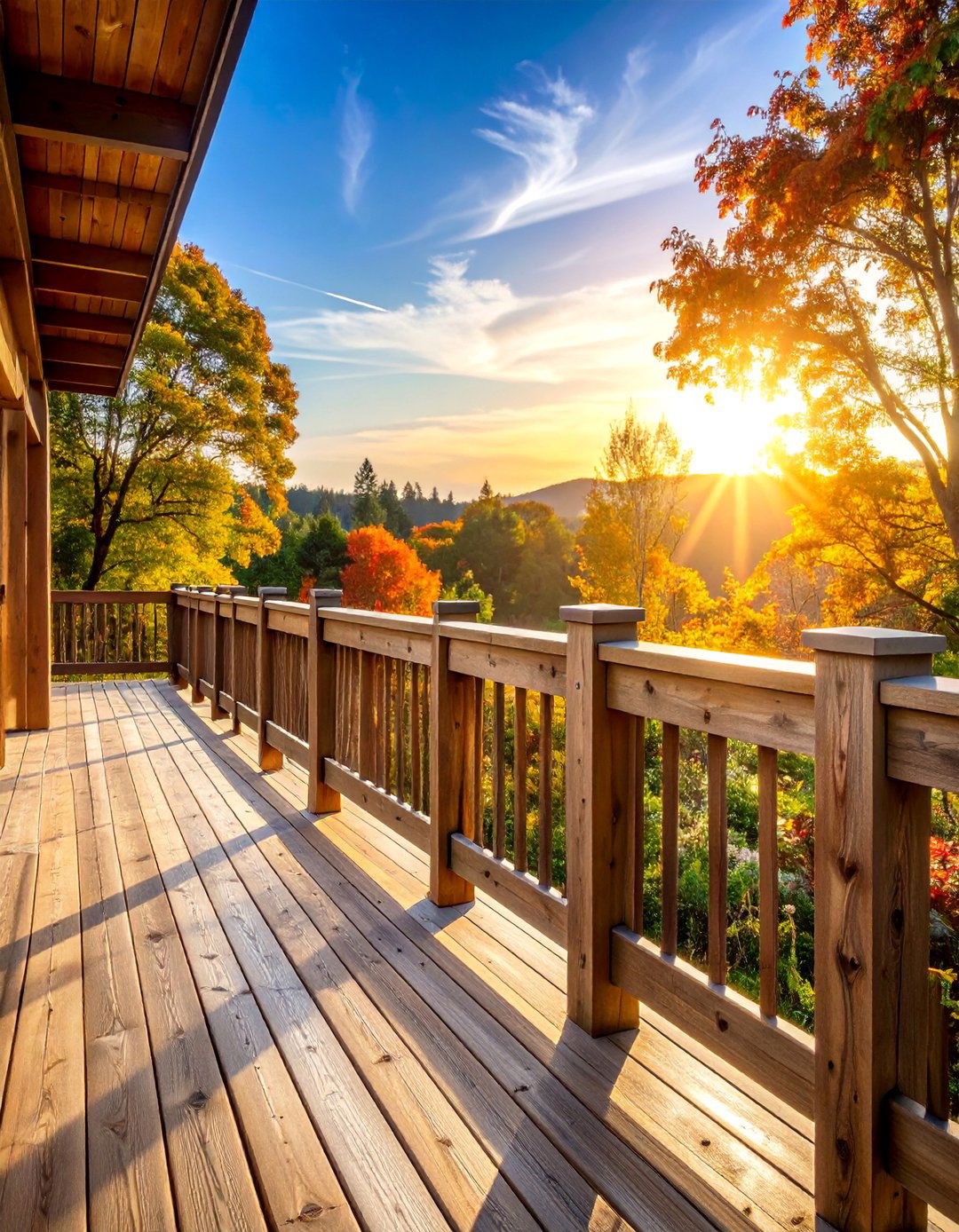
Reclaimed wood railings provide environmental benefits while creating unique character through materials with existing patina and historical significance. These eco-friendly installations typically use salvaged lumber from old barns, factories, or demolished structures, carefully inspected and prepared for outdoor applications. Each piece contributes individual character through natural aging, previous use marks, and varied grain patterns. Proper treatment ensures structural adequacy while preserving authentic weathered appearances. This sustainable approach reduces environmental impact while creating distinctive installations that cannot be replicated through new materials. The resulting railings complement rustic, industrial, and contemporary home styles while demonstrating environmental responsibility through creative reuse of existing resources that might otherwise become waste materials.
Conclusion:
Wood deck railings offer remarkable versatility for creating personalized outdoor living spaces that combine safety with aesthetic appeal. From traditional vertical balusters to innovative mixed-material designs, these twenty-five ideas demonstrate the endless possibilities available to homeowners seeking distinctive deck solutions. Whether your preference leans toward rustic natural elements, sophisticated architectural details, or contemporary minimalist approaches, wood railings can accommodate virtually any design vision while meeting necessary building codes. The key lies in selecting designs that complement your home's architecture, personal style, and outdoor living needs while considering long-term maintenance requirements and local climate conditions for optimal performance and lasting beauty.



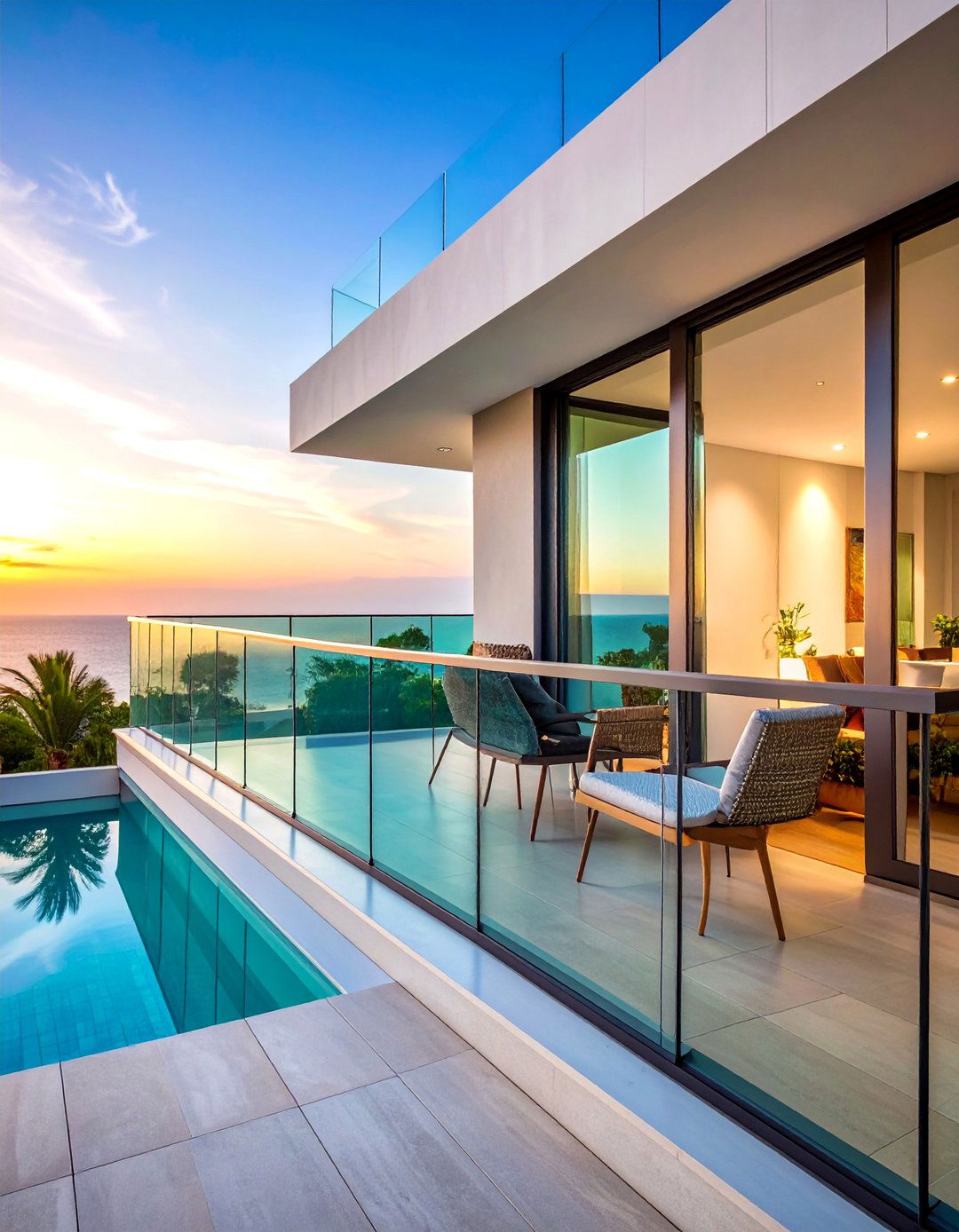
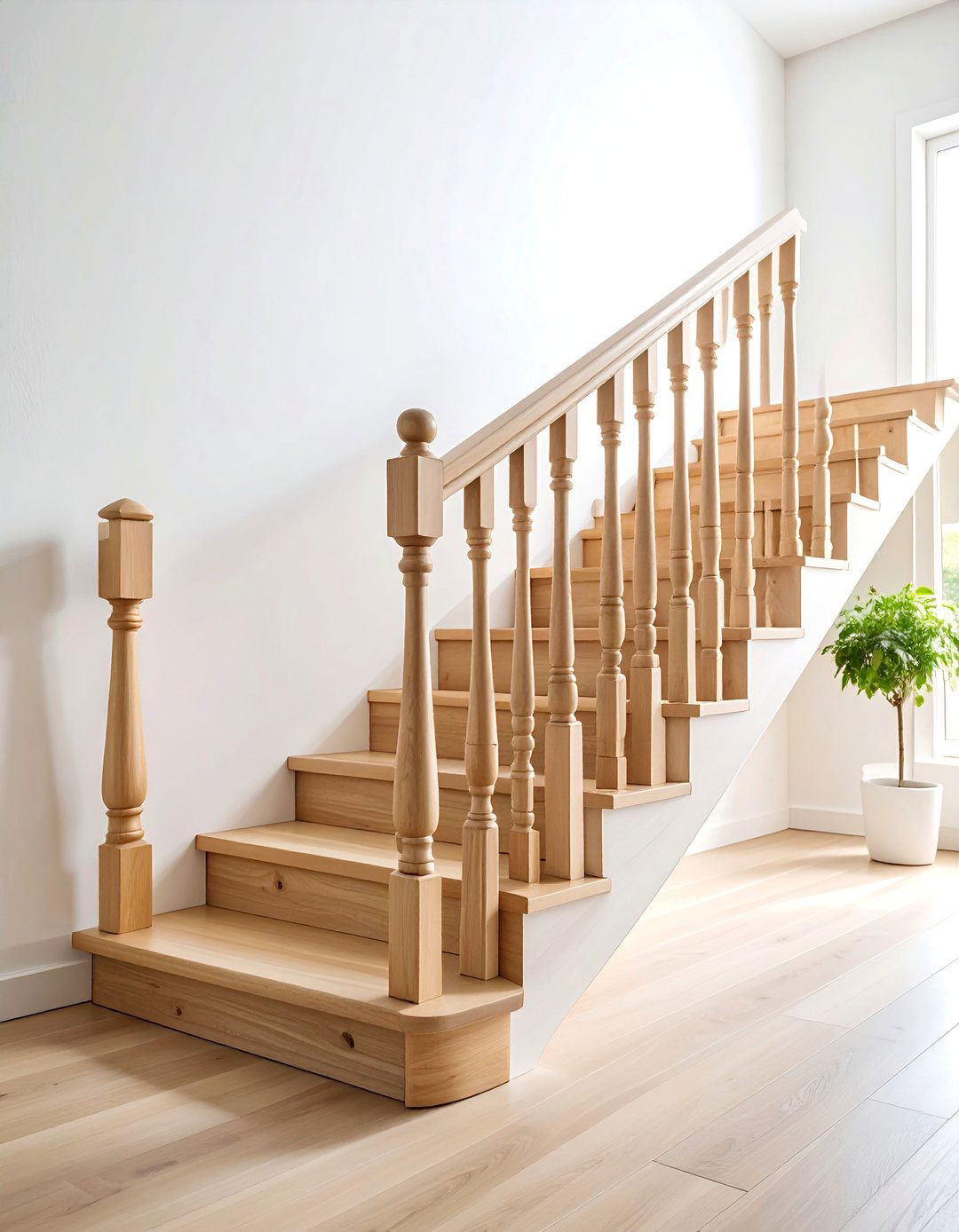



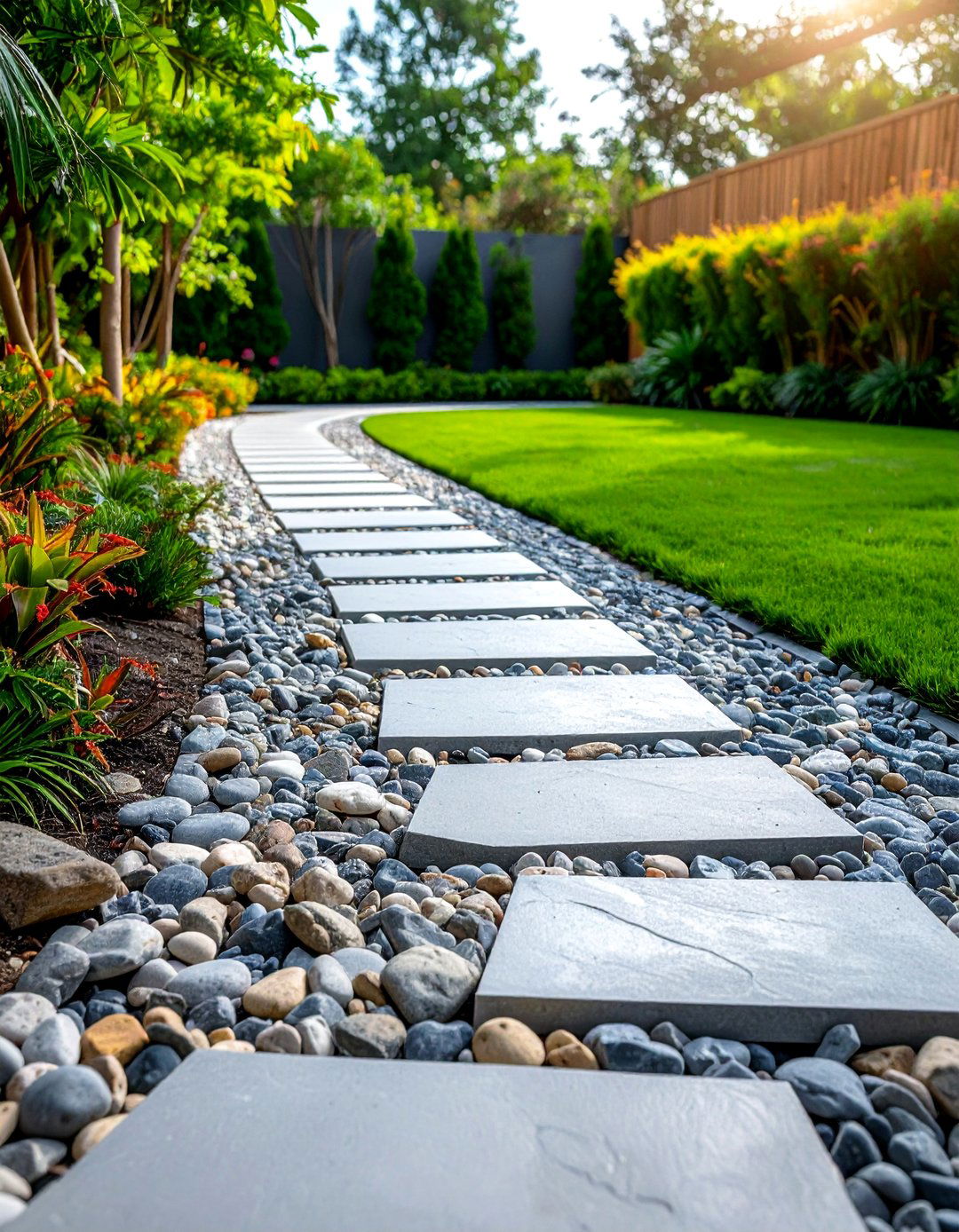

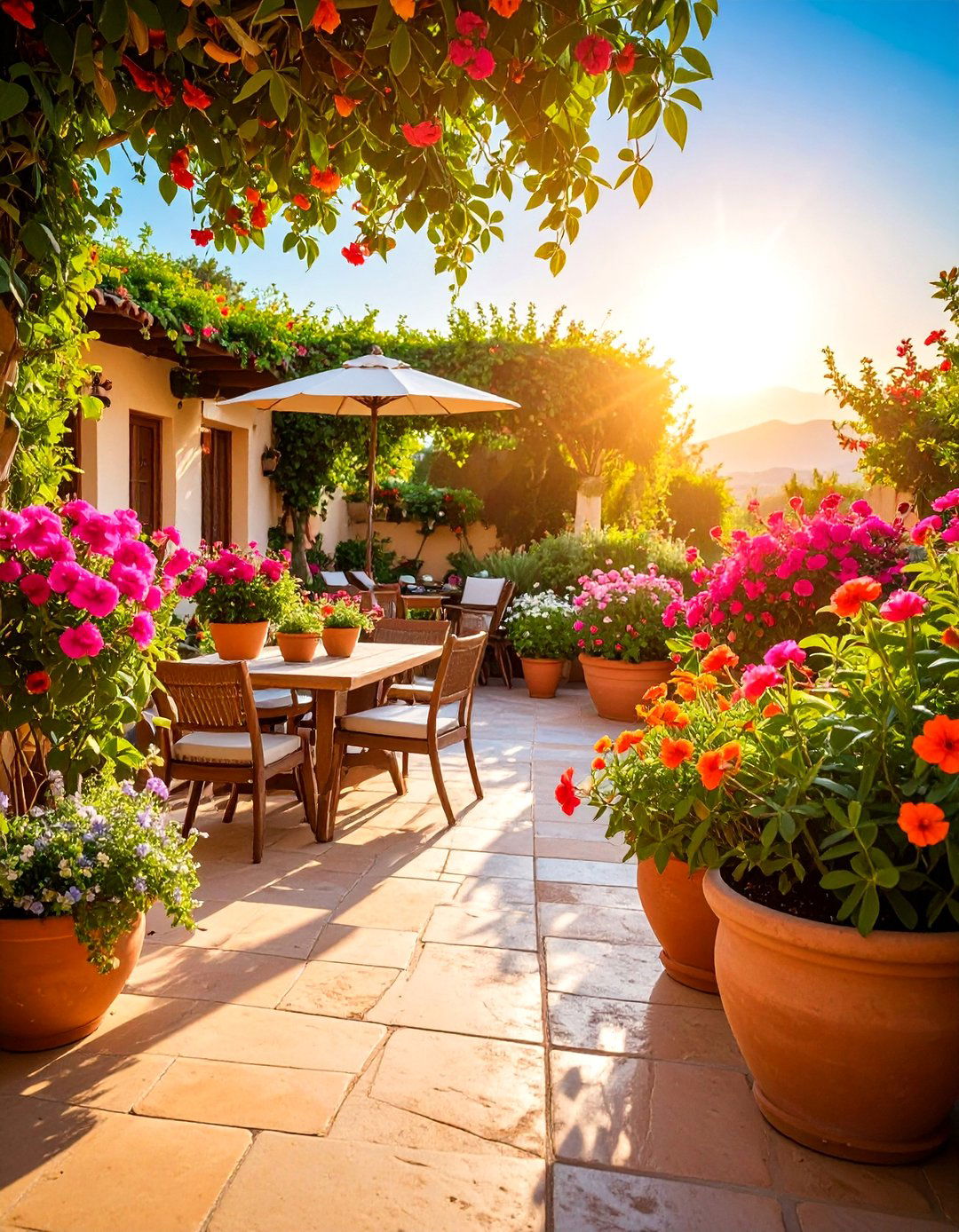

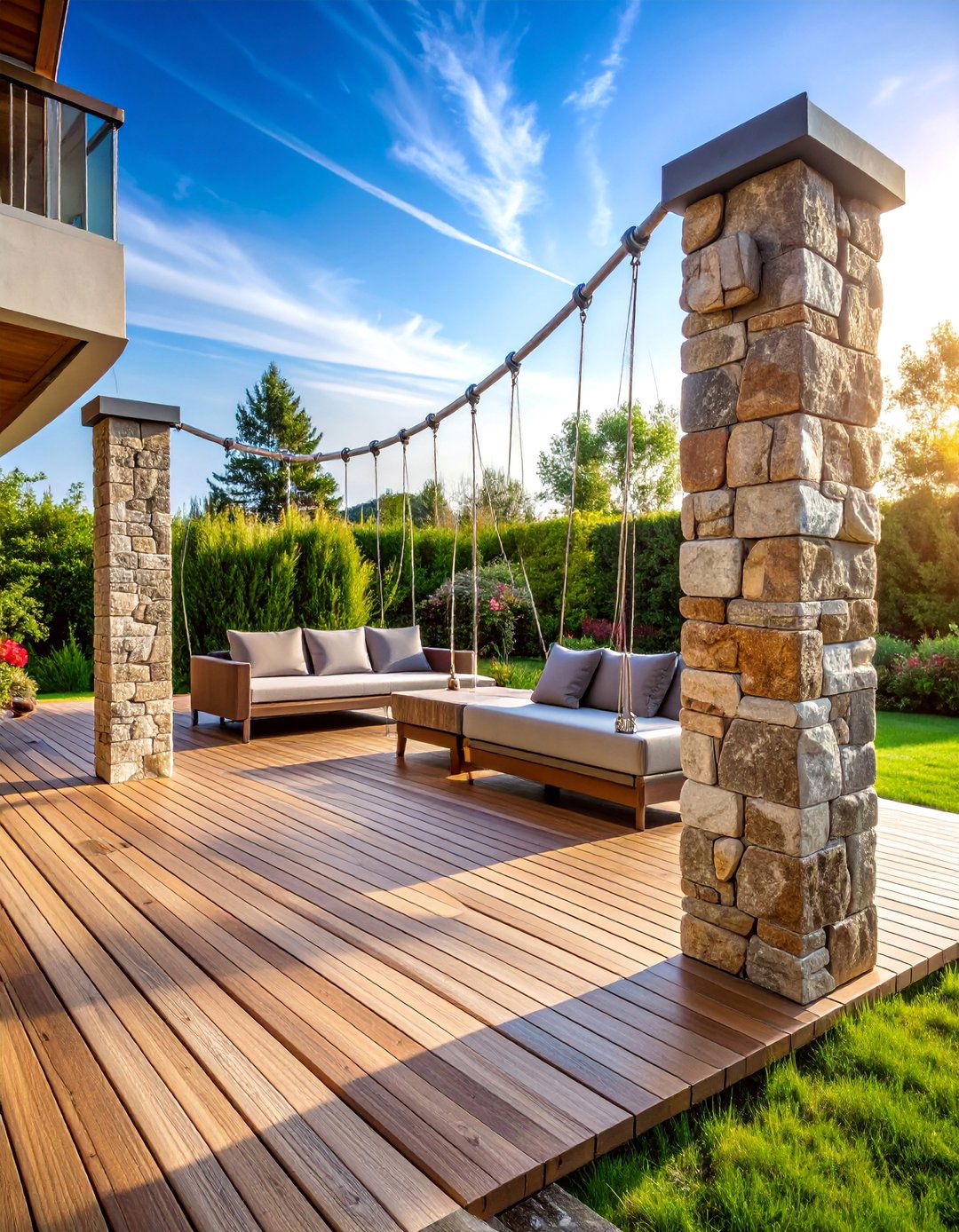
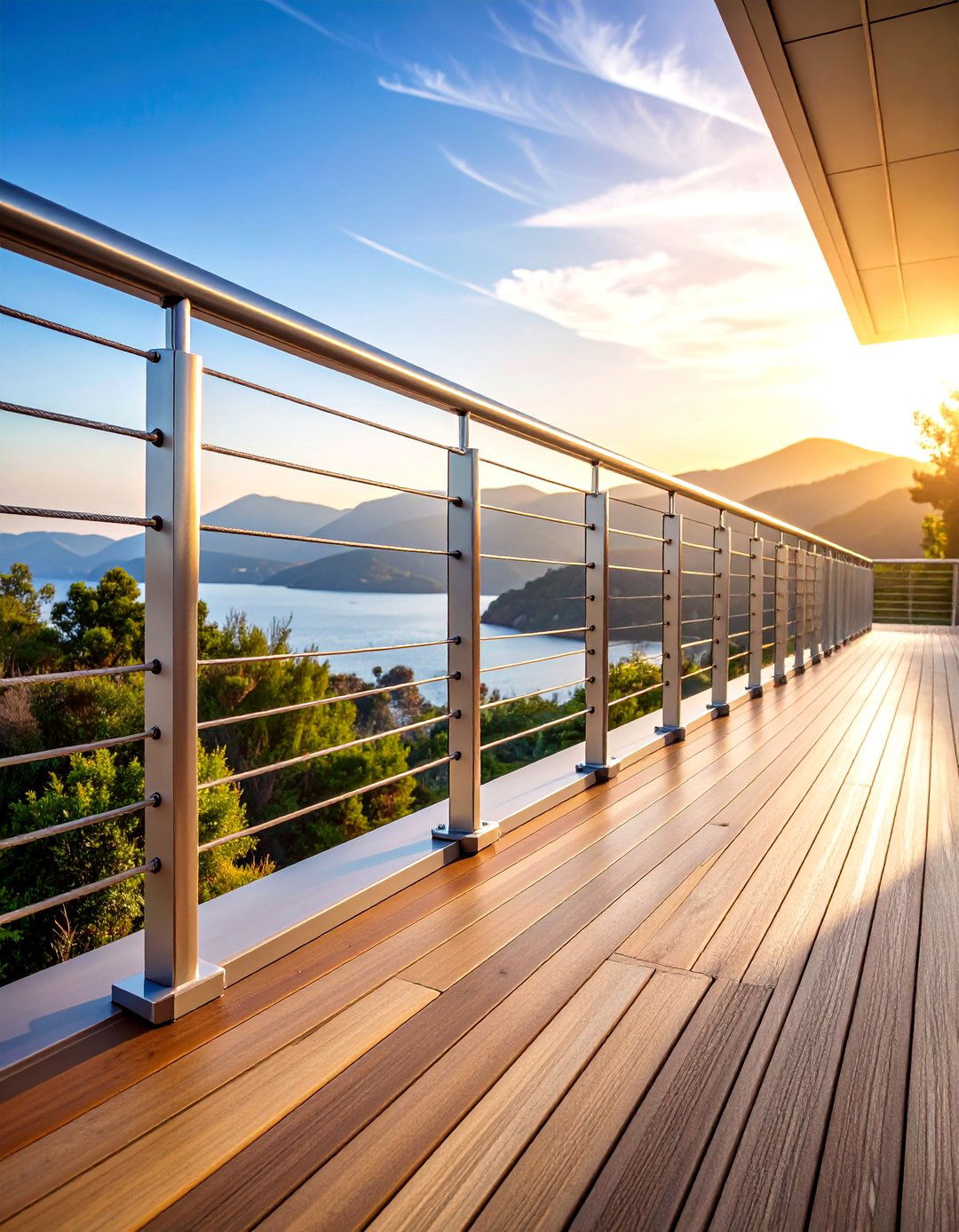
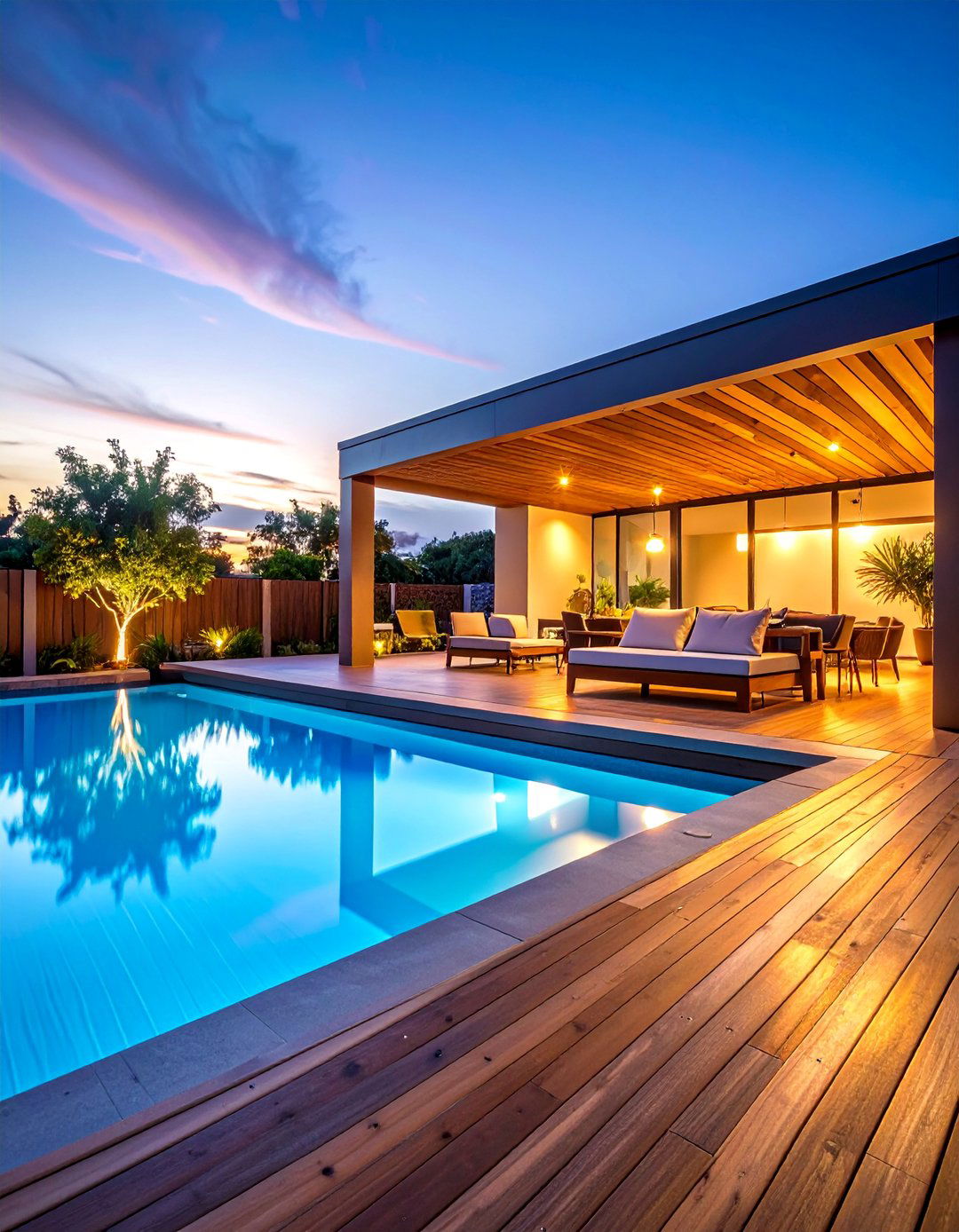

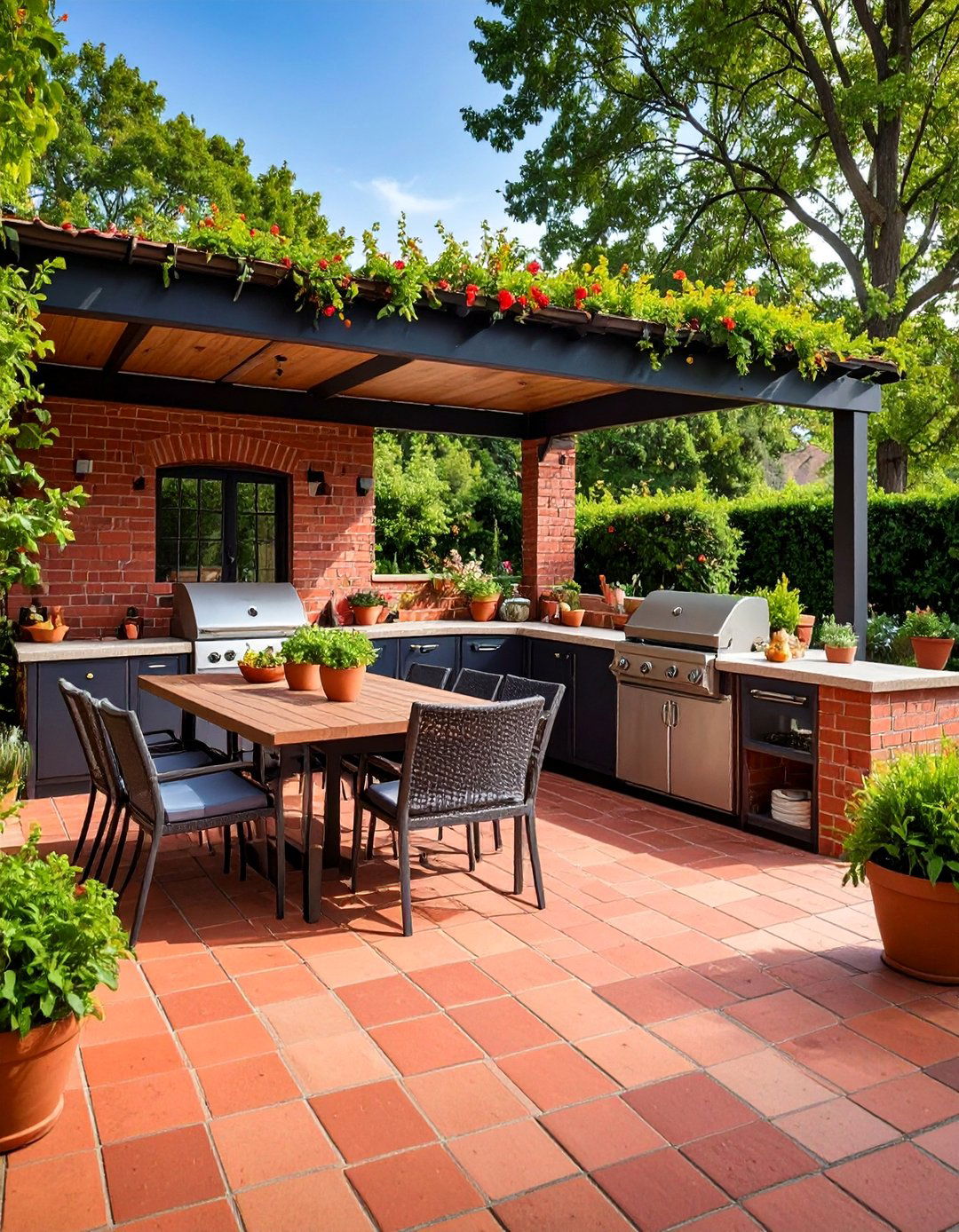
Leave a Reply